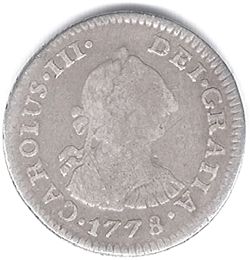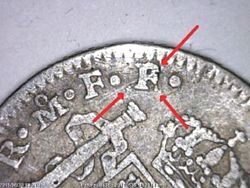Mexico City 1778 Half Real FF/M: An Unlisted Over-Assayer Variety
by Douglas Reil


In the various Spanish colonial series, there are many varieties that result from the reuse of old dies. Such varieties include overdates, repunched elements, and even occasionally over-ordinals in the name of the king. But one of the more unusual varieties is when the new assayers initial is punched over that of the former one.
Across all mints in the portrait half real series there are very few examples of this type of variety. There are only three that I have encountered in my research: the 1776 and 1777 Potosi PR/JR and the very rare 1801 AJ over DA Santiago coin. On the latter, the over-assayer is only evident on high grade coins. But in the relatively well-made dies of the Mexico City coins, there were no listed over-assayer examples, so I was surprised when I came across this piece.

The close-up picture of the reverse clearly shows the “legs” of the M at either side of the base of the F, as indicated by the arrows. The upper arrow points to what looks to be the remains of the M remaining within the upper part of the F. Even in the larger scan, the remains of the M can be seen clearly. There is little doubt that that this is a new over-assayer variety.
As to whether or not other Mexico City half reales feature over-assayer varieties, we can look to the other series for known examples to get a clue. In the portrait one real and two reales series, it is little surprise to find that with the first year of assayer initial change, 1778, there are also over-assayers with both denominations. And in the one real series, there are other dates with this variety including 1780, 1801, and 1802. The 1780 example is quite easy to see and is relatively common. It seems very possible a similar approach for re-tasking dies was used for half reales in those other years as well, as we see the over-assayer in all three denominations in 1778. Collectors should closely check the assayer initials of their half reales for those other dates; a surprise might be waiting!
